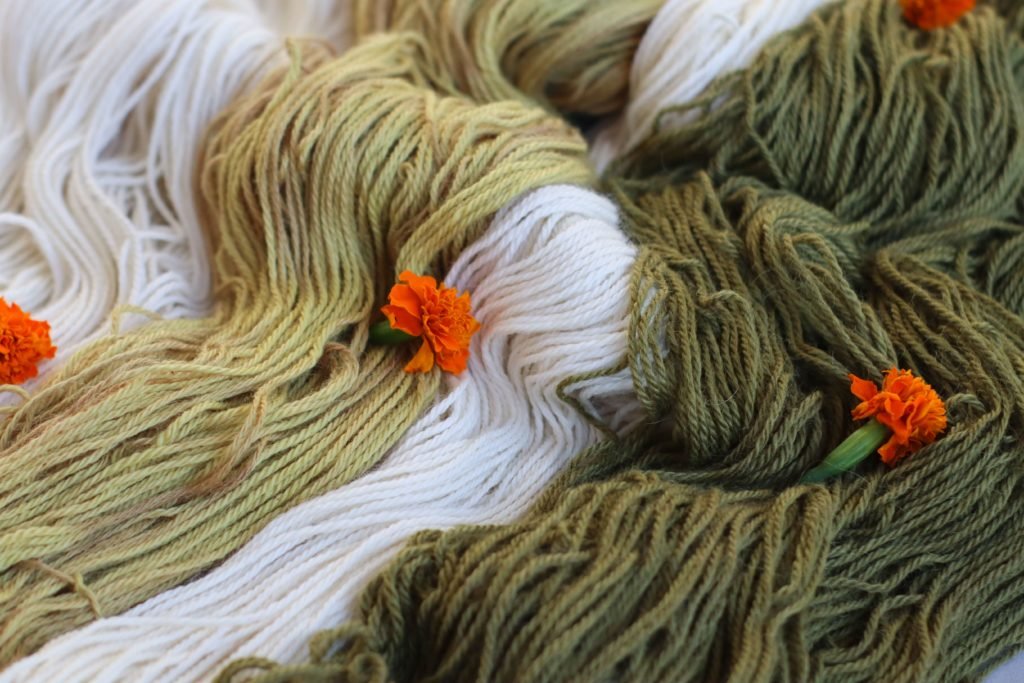Natural Dyes for Wool: Marigolds
It’s summertime as I write this, and in the full swing of summer it’s easy to find those dependably cheery flowers: marigolds! Marigolds are ideal for the beginning gardener. They’re hardy and survive in many different environments, from Zone 2 to Zone 11, when sown as seed on the ground, and the common orange variety (or the red and gold variety) are easy to find as small palleted plants at small and larger nurseries.
This makes marigold one of my top picks for newer dyers, and it’s the perfect flower to start with if you’ve been wanting to play with natural color this summer. Most of all, it’s delightfully prolific–you can gather marigolds every day throughout the summer and they’ll just keep making more blooms for you to use.
The marigolds I used for this tutorial come from my friend Andrea, who harvested them all summer and dried them, then bagged them and shipped them my way. If you’d like to store your marigolds, make sure you get them nice and dry (a repurposed old window screen or two will help) before bagging them, or they will rot.
You can also use marigolds fresh, for entirely different colors. Brighter yellows and even orange-yellows are common from fresh marigolds, while dried marigolds give you more greenish yellow hues, and with the aid of iron, can be shifted into the most lovely greens.
You’ll want quite a lot of flowers to make up the 1:1 concentration of dye material to wool–we’re dyeing 200 g and I used approximately 255 g of dried marigolds. The volume difference of these materials is pretty drastic so make sure you have a deep pot to prepare your dye bath.
How to Naturally Dye Wool with Marigolds and Iron
Materials
For this dye experiment, you’ll want the following materials on hand. Remember, anything you use for natural dyeing must not be used again for food or food prep at any time, and you’ll want to store it separately to avoid any cross-contamination.
- 1 large stainless steel or aluminum soup pot or stock pot
This should be big enough to hold 1-2, 100 g skeins of yarn, covered in water and fully submerged with room to move around.
- Dedicated tools: measuring cup, spoon for stirring, measuring spoons
- A heat source
This could be your at-home stove with good ventilation, a hot plate, a propane burner or even a crock pot. If you’d like to use an upcycled crock pot, you will not need the stock pot, but it will need to stay fully dedicated to natural dyeing as dyes are not food safe.
- A water source
Natural dyes do use a lot of water–for prepping your fibres, creating dye baths, and rinsing finished yarns. You can use rainwater if you like, especially if you find your tap water is influencing your colors negatively. You can test your water’s pH with strips and see how ‘neutral’ it is if you like as a starting point to alter colors to be warmer or cooler. How you alter these will depend on the dye you’re using.
- A respirator or face mask
I typically would not use a respirator or face mask when moving around larger dye goods like flowers or leaves, but if you are using anything powdered–like the iron powder we use to create a bath in this experiment–I recommend having one on. These ultra-small particles just aren’t good to breathe in!
- A scale that can measure grams in small quantities
If you already have a baking scale, you can use it here, just make sure not to let any dyes or materials touch the scale directly. Simply use the tare function to zero-out the weight of any vessels you’re using to measure, then clean off your scale thoroughly after use.
- Aluminium sulfate or Aluminium Potassium Sulfate*
Mordants are chemicals that bind to both the fibre and color, acting as a bridge to attach color molecules to your wool. This chemical is the safest of a handful of options and is popular with many natural dyers. It will only bind color to protein fibres, not cellulose ones–so color taken by the wool may not be taken up the same way by any blended fibres (like cotton, hemp, linen or nylon).
- Cream of Tartar*
Cream of Tartar adds a little softness back into your bath and prevents your wool from feeling too crunchy at the end of the dyeing process.
- Ferrous Sulfate (Iron)
We’ll use this to shift our bath to ‘sadden’ the golds to greens.
- Dried Marigolds (9 oz / 255 g)
Collect your marigolds all summer long and have a dye day in the Fall!
- 2 skeins of Knomad Latte
Who doesn’t dream of a shawl in dreamy greens? I wanted to knit a shawl with two shades of green to remember this height of summer when the winter comes–Baby Alpaca “Latte” is the perfect yarn for this kind of project, with a gentle halo and shine.
- Old clothes
Marigolds (and iron) seem to stain whatever they touch. Wear something you don’t love when working with any natural dyes.
- Gloves
Rubber gloves or kitchen gloves, which can be re-used multiple times, are my preference here. While most natural dyes are perfectly safe to handle with your hands, you’ll be washing, rinsing, and in and out of water a lot, which can damage your nails and cuticles. Keep those knitting hands pretty and get some gloves.
*These items have been pre-calculated in the amount you need for this project, dyeing 200 g of wool, however, you can also do your own calculations using the mordanting guide below.
Step 1: Prep your fibre. Knomad pre-scours and washes their yarns before shipping them to us, so there should be no need to heavily clean the fibres–simply remove the tags, leaving all the ties, and open the hank into a big loop. Add reinforcement ties if you feel they’re necessary, and soak the fibre in warm water for an hour to get it fully saturated (typically 1 hour).
Step 2: Measure the alum. Wearing a respirator or face mask, measure out 12% of your weight of fibre (WOF) in alum sulfate. Here’s the math for our experiment:
200 x 0.12 = 24 g of aluminum sulfate
Hot tip: weigh out how much alum is in a tablespoon (dedicated tablespoon) and then calculate moving forward about how many tablespoons you’ll need to simplify future measuring.
Step 3: Add hot water to your alum in a small mixing container. I like to use empty, recycle-ready plastic containers. Stir the alum and water mixture until the alum is fully dissolved and the water looks cloudy or clear, but has no visible grains in the bottom of the container. Measure out 1 tbsp of Cream of Tartar and dissolve it into the water while it’s still warm.
Step 4: Transfer your mordanting solution to a larger stock pot, and fill with enough water to cover your skeins of yarn (don’t add them until the pot has all the water in it). Stir and then add your yarn, moving it around to let it fully absorb the mordanting solution. Set on low heat and simmer (do not boil) for 1 hour. Allow to cool overnight with the yarn in the solution.
Step 5: Make your dye bath. Marigolds are so easy to use: simply add the dried flower heads to water in a stock pot, and push the flowers under with a spoon while you bring it to a simmer. Let it sit at this temperature for an hour, then turn it off and allow it to cool. Strain out the flower heads and save them for another dye bath later, they’re good for another steep!
Step 6: Add your yarns gently to the dye bath, making sure that the yarn has enough room to move around but is mostly submerged in the pot. If you need more water, it’s okay to add some here. Bring the yarn and dye bath back up to a high heat without simmering or bubbling, let it sit at this temperature for 1 hour, then turn off the heat and allow it to cool. Remove one skein to shift with iron.
Step 8: Make an iron bath. To create an iron bath, you’ll need Iron Powder, or Ferrous Sulfate, mixed with water. Iron is a modifier that ‘saddens’ the color of your yarn, in this case changing a bright, greenish yellow to a deeper, more olive green.
Measure out 3% the weight of your fibre for a major shift as shown, or less for a more subtle shift (or create your own gradient by making each mini skein shift a bit more). I used 12 g for 100 g of fibre, and saved the iron bath in a recycled jar to use again later (make sure to mark what it is and keep it out of the reach of pets and kids).
Step 9: Rinse, especially your iron skein (the iron is okay to go down the drain in your home and will be filtered out of the water system, but septic tank users may want to double-check), then hang to dry out of the direct sun. I use a portable drying rack.
They will drip a little bit, so if you need to dry them indoors, I suggest putting them in a bathtub or in a room with a drain (like a basement). Depending on your humidity and weather, it can take 1-2 days for yarn to fully dry, but maneuvering it so that the same part of the hank is not always hanging down can help move this process along a bit.
Marigold is one of my favorite dyes to use and I love the range of greenish golds (my favorite color) that is achievable with the use of modifiers! Now… off to cast on that shawl.
Tags: beautiful yarn, soft yarn, the best yarn














